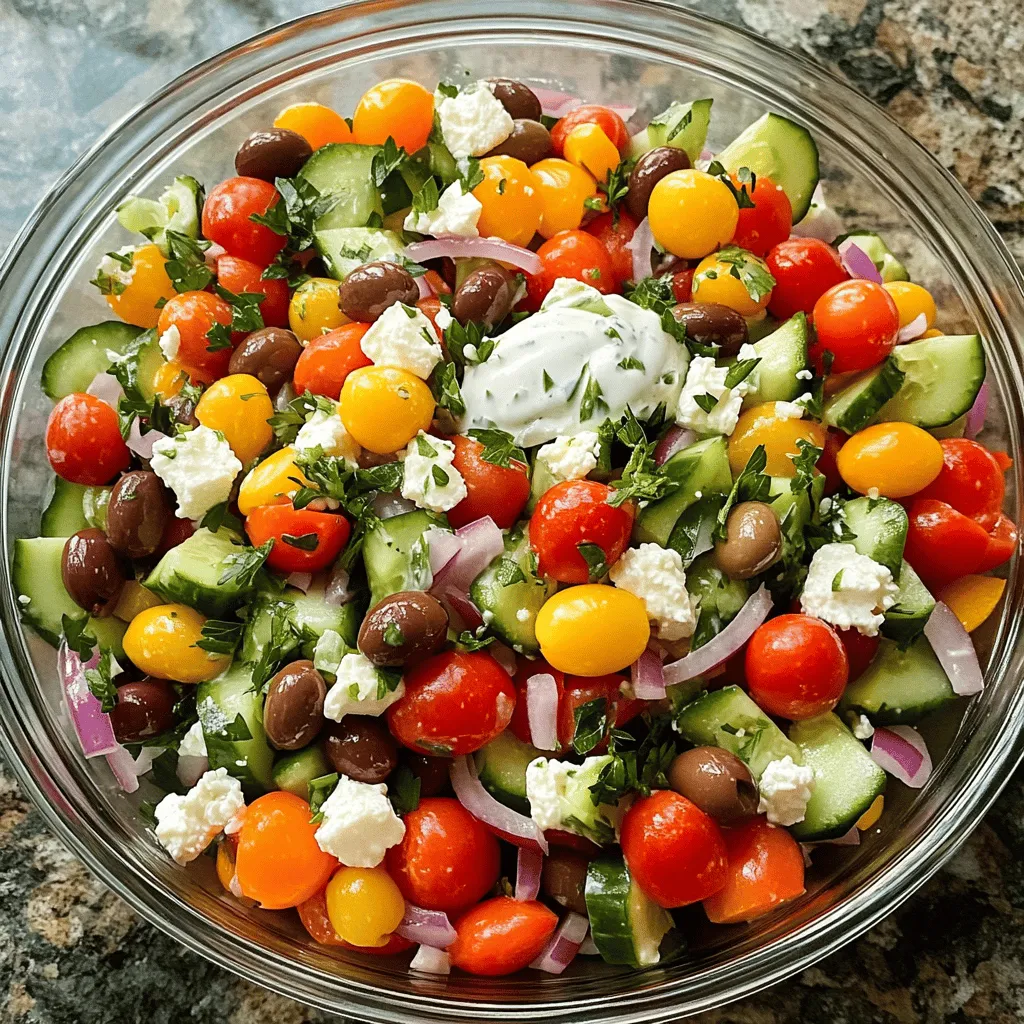Looking for a delicious and fresh salad that excites your taste buds? My Creamy Greek Salad is perfect for you! With vibrant colors and bold flavors, this easy dish combines fresh veggies and a rich, creamy dressing that will make your meals shine. In this blog post, I’ll share the best ingredients, simple steps, and handy tips to create this delightful salad. Let’s dive into a world of flavor together!
Ingredients
List of Ingredients for Creamy Greek Salad
To make a tasty Creamy Greek Salad, gather these fresh ingredients:
– 2 cups vibrant cherry tomatoes, halved
– 1 crisp cucumber, diced into bite-sized pieces
– 1 medium red onion, thinly sliced for a mild crunch
– 1 bell pepper (your choice of color), diced for sweetness
– 1 cup pitted Kalamata olives, known for their bold flavor
– 1 cup creamy feta cheese, crumbled
– 1/2 cup plain Greek yogurt for a rich dressing
– 2 tablespoons extra virgin olive oil for a smooth texture
– 2 tablespoons freshly squeezed lemon juice for brightness
– 1 teaspoon dried oregano, adding an aromatic touch
– Salt and freshly ground black pepper to taste
– Fresh parsley or mint, finely chopped, for garnish
Notes on Ingredient Quality
Using high-quality ingredients makes a big difference. Choose ripe tomatoes and crisp cucumbers. Fresh herbs add a burst of flavor. Opt for real Greek yogurt and extra virgin olive oil. These choices elevate your salad, making it rich and delicious.
Optional Additional Ingredients
You can customize your salad with extra ingredients. Try adding diced avocado for creaminess. Roasted red peppers bring a sweet twist. For a protein boost, grilled chicken or chickpeas work well. Feel free to get creative!
Step-by-Step Instructions
Preparing the Salad Base
To start, gather your vibrant ingredients. Take 2 cups of halved cherry tomatoes and place them in a large mixing bowl. Next, add a crisp cucumber, diced into bite-sized pieces. I like to use one medium red onion, thinly sliced, for a mild crunch. Then, include one diced bell pepper, your choice of color, for some sweetness. Finally, toss in 1 cup of pitted Kalamata olives. These olives bring a bold flavor that pairs well with the fresh veggies. Gently mix everything together to create a colorful salad base.
Making the Creamy Dressing
In a separate small bowl, combine 1/2 cup of plain Greek yogurt with 2 tablespoons of extra virgin olive oil. Add 2 tablespoons of freshly squeezed lemon juice for brightness. Sprinkle in 1 teaspoon of dried oregano for an aromatic touch. Don’t forget to add a pinch of salt and freshly ground black pepper to taste. Whisk this mixture until it becomes smooth and creamy. This dressing will coat your salad beautifully.
Combining Ingredients for Maximum Flavor
Now, pour the creamy dressing over your mixed salad. Toss gently to ensure every piece is coated. After that, carefully fold in 1 cup of crumbled feta cheese. Be gentle to keep the creamy texture intact. Taste the salad and adjust the seasoning with more salt, pepper, or lemon juice if needed. Let the salad rest for about 10-15 minutes at room temperature. This gives the flavors time to meld together. Just before serving, sprinkle freshly chopped parsley or mint on top for a burst of color and freshness. Enjoy your creamy Greek salad as a delightful side or main dish! For the full recipe, check out the details above.
Tips & Tricks
Secret to Perfectly Creamy Dressing
To make your dressing smooth and creamy, use high-quality Greek yogurt. It should be thick and rich. Mix it with olive oil and lemon juice for a bright flavor. Whisk until the texture is velvety. If you want a little kick, add a dash of garlic powder. This makes the dressing pop. Always taste it before adding to your salad. Adjust with salt, pepper, or more lemon juice as needed.
Presentation Tips for Serving
When serving your creamy Greek salad, use a large, shallow bowl. This allows the colors to shine. Arrange the ingredients artfully, so each layer shows. Drizzle any extra dressing on top for a finishing touch. Sprinkle more crumbled feta and fresh herbs just before serving. This not only adds flavor but also makes it look inviting.
Common Mistakes to Avoid
One common mistake is over-mixing the salad. This can break the feta cheese into tiny bits. Instead, gently fold it in to keep its chunks intact. Another mistake is using low-quality ingredients. Fresh tomatoes and crisp cucumbers make a big difference. Lastly, don’t skip the resting time. Letting the salad sit for 10-15 minutes helps flavors blend. This enhances the overall taste of your dish.

Variations
Adding Protein for a Complete Meal
You can turn this salad into a full meal by adding protein. Grilled chicken or shrimp work great. Just slice them and mix them in. You can also use chickpeas, which add fiber and protein. They are perfect for a hearty meal. If you prefer fish, try canned tuna or salmon. Both add a nice flavor and boost the nutrition.
Vegetarian and Vegan Adaptations
If you want a vegetarian version, simply leave out the feta cheese. You can add avocado for creaminess instead. For a vegan option, use plant-based yogurt in place of Greek yogurt. This gives you the same creamy texture without dairy. You can also add nuts or seeds for extra crunch and protein.
Seasonal Variations with Fresh Ingredients
Using seasonal ingredients makes this salad even better. In summer, add fresh corn or zucchini for sweetness. In fall, try roasted butternut squash or apples for warmth. Winter brings hearty greens like kale or arugula, which can add depth. Always look for local produce to keep your salad fresh. Each season offers something unique to enhance the flavor and nutrition.
Try the Full Recipe for all these delicious ideas.
Storage Info
Best Practices for Storing Leftovers
To keep your Creamy Greek Salad fresh, first, place it in an airtight container. This will help keep out air and moisture. Store it in the fridge to maintain its crispness. If you have extra dressing, store it separately. This way, the salad won’t get soggy. When you’re ready to eat, mix in the dressing again for the best taste.
How Long Does It Last in the Fridge?
Your Creamy Greek Salad will last about 3 days in the fridge. After that, the veggies may lose their crunch. Always check for any off smells or changes in texture. If it looks or smells odd, it’s best to toss it out. Enjoy it while fresh for the best flavor!
Freezing Tips for Creamy Greek Salad
Freezing this salad isn’t the best idea. The veggies will get mushy when thawed. However, if you want to freeze it, leave out the cucumbers, tomatoes, and olives. You can freeze the dressing and feta cheese separately. To use, thaw everything in the fridge overnight and mix it fresh. This way, you can still enjoy a taste of Greek delight!
For the full recipe, check out the Creamy Greek Salad Delight section!
FAQs
What is the origin of Greek salad?
Greek salad, or horiatiki, comes from Greece. It reflects the country’s love of fresh, local foods. This dish typically features tomatoes, cucumbers, and olives. It often includes feta cheese too. Each region in Greece has its own twist on this salad. Some use capers or green peppers. The key is to use fresh ingredients. Greek salad is a staple at many meals. It pairs well with grilled meats and seafood.
How can I make a low-calorie version?
To make a low-calorie version, swap some ingredients. Use low-fat Greek yogurt instead of regular. You can reduce the cheese or use a lighter cheese. Skip the olives or use fewer for less fat. Increase the veggie portion for volume. Add more cucumbers or tomatoes for crunch. A splash of vinegar can replace some olive oil too. This way, you keep the flavor while cutting calories.
Can I use different types of cheese?
Yes, you can use different cheeses! Feta is traditional, but you can try others. Goat cheese adds a creamy tang. Mozzarella gives a mild flavor and soft texture. For a sharper taste, try aged cheddar. Just remember to adjust the amount. Each cheese has its own saltiness and fat content. Choose one that fits your taste and diet.
This blog post covered the key elements for making a creamy Greek salad. We discussed the essential ingredients and the importance of quality. You learned how to prepare the salad base and make a creamy dressing. I shared tips for a perfect dressing and ways to avoid common mistakes. We also explored variations to suit your taste and how to store leftovers.
In my view, a creamy Greek salad is both fun to make and delicious to eat. Enjoy trying out these recipes!

